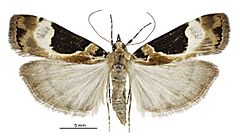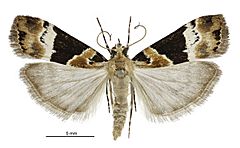Eudonia aspidota facts for kids
Quick facts for kids Eudonia aspidota |
|
|---|---|
 |
|
| Female | |
 |
|
| Male | |
| Scientific classification | |
| Kingdom: | |
| Phylum: | |
| Class: | |
| Order: | |
| Family: | |
| Genus: |
Eudonia
|
| Species: |
E. aspidota
|
| Binomial name | |
| Eudonia aspidota (Meyrick, 1884)
|
|
| Synonyms | |
|
|
Eudonia aspidota is a moth in the family Crambidae. It is found in New Zealand.
Taxonomy
This species was first described by Edward Meyrick in 1884 and named Xeroscopa aspidota. Meyrick added further detail when he described the species later in 1884. In 1913 Meyrick placed the species within the genus Scoparia.
Description
The wingspan is 22–26 mm. The forewings are light ochreous, sometimes mixed with reddish-ochreous. There is a black white-margined triangular spot on the costa. The hindwings are pale grey with a darker grey post medial and hind marginal line.
Although the wing markings of this species attract attention, they also imitate bird droppings. This mimicry offers protection to E. aspidota when it is not in flight.
Distribution
E. aspidota is endemic in New Zealand. Meyrick stated it could be found in Wellington, Castle Hill, Mount Hutt, Dunedin and Lake Wakatipu. George Hudson added to the localities where E. aspidota could be found and included Raurimu, Waimarino, Buller River, Invercargill and Stewart Island. Hudson was of the opinion that the species was probably distributed throughout New Zealand.
Ecology and habitat
The habitat of this species is amongst forest.
Host plants
The larvae of this species lives on mosses.
Occurrence
Adults of E. aspidota are normally present during December and January. This species is attracted to light.
Images for kids
 | Jewel Prestage |
 | Ella Baker |
 | Fannie Lou Hamer |



